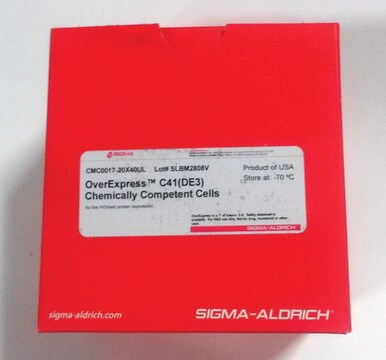71183
Sodium acetate
anhydrous, BioUltra, for luminescence, for molecular biology, ≥99.0% (NT)
Synonym(s):
Sodium acetate anhydrous, Acetic acid Sodium salt anhydrous, Acetic acid sodium salt
About This Item
Recommended Products
grade
for luminescence
for molecular biology
Quality Level
product line
BioUltra
Assay
≥99.0% (NT)
form
solid
autoignition temp.
1112 °F
impurities
DNases, none detected
RNases, none detected
insoluble matter, passes filter test
phosphatases, none detected
proteases, none detected
loss
≤0.5% loss on drying, 150 °C
pH
8.5-10.0 (25 °C, 3 M in H2O)
pKa
4.76 (acetic acid)
mp
>300 °C (dec.) (lit.)
solubility
H2O: 3 M at 20 °C, clear, colorless
anion traces
chloride (Cl-): ≤20 mg/kg
phosphate (PO43-): ≤5 mg/kg
sulfate (SO42-): ≤20 mg/kg
cation traces
Al: ≤5 mg/kg
As: ≤0.1 mg/kg
Ba: ≤10 mg/kg
Bi: ≤5 mg/kg
Ca: ≤10 mg/kg
Cd: ≤5 mg/kg
Co: ≤5 mg/kg
Cr: ≤5 mg/kg
Cu: ≤5 mg/kg
Fe: ≤5 mg/kg
K: ≤200 mg/kg
Li: ≤5 mg/kg
Mg: ≤5 mg/kg
Mn: ≤5 mg/kg
Mo: ≤5 mg/kg
Ni: ≤5 mg/kg
Pb: ≤5 mg/kg
Sr: ≤10 mg/kg
Zn: ≤5 mg/kg
SMILES string
[Na+].CC([O-])=O
λ
3 M in H2O
UV absorption
λ: 260 nm Amax: 0.03
λ: 280 nm Amax: 0.02
InChI
1S/C2H4O2.Na/c1-2(3)4;/h1H3,(H,3,4);/q;+1/p-1
InChI key
VMHLLURERBWHNL-UHFFFAOYSA-M
Looking for similar products? Visit Product Comparison Guide
Application
- protein crystallization
- staining of gels in protein gel, electrophoresis, neutralization buffer for chromatography
- the preparation of standard (acetylcholine chloride) for hestrin assay
- substrate screening characterization for microfluidic microbial fuel cell array
Biochem/physiol Actions
Other Notes
Storage Class Code
11 - Combustible Solids
WGK
WGK 1
Flash Point(F)
Not applicable
Flash Point(C)
Not applicable
Personal Protective Equipment
Regulatory Listings
Regulatory Listings are mainly provided for chemical products. Only limited information can be provided here for non-chemical products. No entry means none of the components are listed. It is the user’s obligation to ensure the safe and legal use of the product.
JAN Code
71183-6X250G:
71183-1KG:
71183-250G:
71183-VAR:
71183-BULK:
Certificates of Analysis (COA)
Search for Certificates of Analysis (COA) by entering the products Lot/Batch Number. Lot and Batch Numbers can be found on a product’s label following the words ‘Lot’ or ‘Batch’.
Already Own This Product?
Find documentation for the products that you have recently purchased in the Document Library.
Customers Also Viewed
Our team of scientists has experience in all areas of research including Life Science, Material Science, Chemical Synthesis, Chromatography, Analytical and many others.
Contact Technical Service







